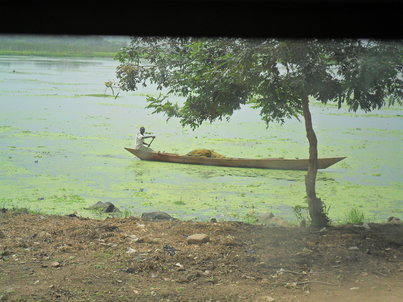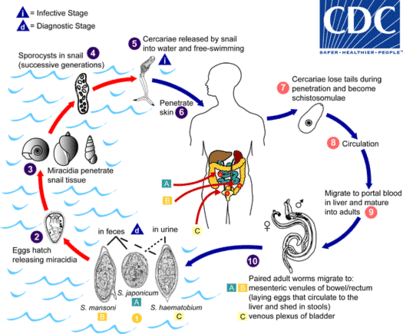Schistosomes
Worldwide nearly 250 million people — mostly in sub/tropical countries — required preventive treatment against schistosomiasis in 2014 and more than 200,000 deaths occur each year in Sub-Saharan Africa alone. Infection is transmitted upon contact with worm-contaminated water with highest infection rates occurring in fishermen (video) and carwashers (video). The treatment of choice is praziquantel, however, resistances to praziquantel are increasingly being reported and alternative treatment is expensive and less effective. Since praziquantel needs the help of a competent immune system to kill the worms, it is poorly efficient in very young children with immature immune systems or those with compromised immune function. Thus, novel, more potent and affordable drugs are needed against this parasite.
Schistosomes are flatworms with two suckers that live within the blood vessels of the gut or the bladder. Adult schistosomes stay together as couples with the sturdy males carrying the slender females in their ventral cleft, and may live for years and even decades causing a potentially life-threatening disease (video).
The life cycle of schistosomes is characterized by a host change
In order to reproduce, schistosomes must change between humans (or other mammalians) and certain water snails.
Mature Schistosoma mansoni eggs with a miracidium hatching
The miracidium is the ciliated larva within the schistosome egg. Shortly before hatching, it starts rapidly rotating until the egg shell bursts, and quickly leaves the egg.<
The miracidium infects water snails (Biomphalaria glabrata), the intermediate hosts of Schistosoma mansoni, where it develops / divides into fork-tailed larvae (cercariae).
The fork-tailed larvae (cercariae) are released from the snails into the water, where they are looking for a host.

Fisherman in a schistosomiasis-endemic area down-stream Lake Volta, Ghana (by courtesy of Arne Homann)
The cercariae infect people who have contact with contaminated water such as fishermen by penetrating their skin (further pictures on risky sites).

